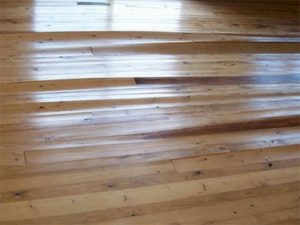Floor Cupping

Foundation Waterproofing 101 specializes in diagnosing and fixing floor cupping across Florida. Because of the state’s high humidity and water table, hardwood floors are highly vulnerable to moisture imbalances that cause cupping, buckling, and crowning. Below we break down the main signs, causes, and solutions—supported by building code requirements and expert resources.
What is Floor Cupping?
Floor damage happens when the edges of hardwood planks rise higher than the center, creating a concave shape. This results from moisture imbalance—when wood absorbs more water on the underside than the surface. Over time, this can lead to cracked boards, peeling finishes, or even structural damage [source].
Floor Cupping Signs Florida
- Visible concave or rippled appearance in hardwood boards.
- Increased squeaking or creaking underfoot.
- Peeling finishes or staining across floor surfaces.
- Localized buckling when moisture sources are severe.
- Efflorescence – Deposits on tile and Concrete
Floor Cupping Issues in Florida

1. Crawlspace Moisture
Standing water or high humidity in crawlspaces allows moisture to migrate into the subfloor and hardwood, creating widespread cupping. Florida’s humid climate accelerates this process [source].
2. Slab Homes and Water Tables
Florida’s high water table makes slab-on-grade construction especially vulnerable. If the first floor is not built at least 12 inches above finished grade as required by Florida Building Code, rising groundwater will eventually contact the slab and penetrate the floor [source]. Over 8–12 years, the vapor barrier beneath the slab deteriorates, leading to floor damage.
3. Subfloor Moisture Imbalance
When the subfloor holds more moisture than the hardwood itself, the planks absorb that excess, causing cupping. Preventive layers like Aquabar underlay or thicker plastic sheeting in crawlspaces reduce this risk [source].
Preventing Floor Cupping
- Maintain humidity between 35%–55%: Use dehumidifiers and HVAC systems during summer months [source].
- Install effective vapor barriers: Use heavy-duty underlays and moisture sealants during construction or renovations.
- Improve drainage: Ensure grading directs water away from the foundation.
- Address leaks fast: Repair plumbing leaks and clean spills immediately to prevent localized cupping.
Fixing Hardwood Floor Cupping
Not all cupping requires replacement. The first step is always moisture control. If the moisture source is corrected and humidity levels stabilize, slightly cupped floors may return to normal over time. Severe cases may need professional repairs such as board replacement, sanding, and refinishing [source].
Professional Floor Cupping Diagnosis & Repair
If your hardwoods are cupping, don’t wait for them to buckle or rot. Schedule a professional inspection or call 813-614-4830 today. Stopping moisture at the source protects your floors, your substructure, and the long-term value of your home.
Floor Cupping FAQs
Will cupped hardwood floors flatten out on their own?
Mild cupping can sometimes correct itself if humidity is stabilized and the moisture source is fixed. Severe or long-term cupping often needs professional sanding or board replacement after the moisture issue is resolved.
How long does it take for floors to flatten after moisture control?
It can take several weeks to months for wood to equalize once humidity is controlled. Patience is important before sanding or refinishing — otherwise permanent damage can occur.
Can a dehumidifier alone fix cupping?
Portable dehumidifiers may help reduce symptoms, but they rarely solve the root cause if water is entering from the crawlspace, slab, or poor drainage. True prevention usually requires addressing the moisture pathway.
Who will inspect my cupped floors?
Your inspection will be performed by Jeff Earl, CEO and water hydraulics engineer of Foundation Waterproofing 101 — not a commissioned salesperson. You’ll get a scientific diagnosis and a clear, durable plan.
Trust Foundation Waterproofing 101
We are Florida’s leading waterproofing experts, and we know how to properly diagnose and fix floor cupping. Our inspections identify the root moisture cause, and our solutions ensure your foundation and flooring remain protected for years to come.
Contact Us: Schedule your free inspection today using the form below, or call our office directly to discuss your floor damage concerns.
